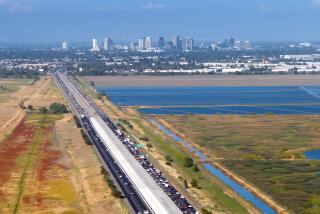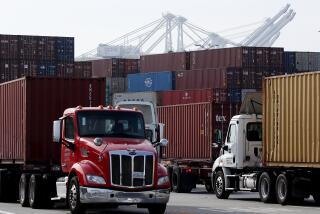Big rigs put the squeeze on smaller vehicles
- Share via
A drive around the packed Los Angeles freeway system on any day will bring you lane to lane with big-rig freight trucks that all too often suddenly swerve out of their own lanes and into yours. If you are lucky, you can scoot over a few inches and avoid being sideswiped.
The truck drivers are not playing chicken. The problem is one of geometry and physics that make for unsafe conditions on the freeways that carry the freight of this region’s economy.
“They do it all the time,” said Jerry Donaldson, research chief at the Washington-based group Advocates for Highway Safety, referring to trucks that stray. “Ever since the late 1970s, the trucking industry has ratcheted up truck sizes.”
Tractor-trailer rigs use more of their lane than any other vehicles on the road. States have jurisdiction to set both lane widths and truck widths, but almost all states conform to standards set by a little-known publication called the Green Book, technically titled “A Policy on Geometric Design of Highways and Streets.”
The book is published by the American Assn. of State Highway and Transportation Officials, a quasi-governmental organization that holds enormous power over highway safety.
“Twelve feet is the standard recognized width for interstate lanes,” said Ken Kabitsky, a highway engineer with the group.
And under most state regulations, the current maximum allowable width for a truck is 8 1/2 feet, he said. That present standard jumped from 8 feet in the early 1990s after heavy lobbying by the trucking industry.
So, the 144 inches of standard lane width on interstates -- minus about 4 inches to 6 inches for lane marker lines -- gives big-rig trucks about 18 inches or 19 inches of clearance on each side of the truck. (In California, trucks have an optional standard that allows 108 inches of width from tire to tire, reducing clearance to as little as 15 inches on each side.)
By contrast, most cars are a maximum of 7 feet wide, so they have at least 27 inches of clearance on each side. Many cars have much more.
Asked why trucks so often stray out of their lanes, Kabitsky said, “You have 1 1/2 feet less clearance in a truck than you have in a car. The probability of that happening is greater in a truck.”
The problem is compounded by the very nature of heavy trucks, which don’t drive like cars. They tend to wander, and the heavier loads make them even more difficult to control. The trucks can experience oscillations of the rear trailer, especially in windy conditions. Unless the driver is alert and paying attention every moment, a truck tends to wander back and forth across lane lines.
“Trucks are more difficult to control,” acknowledged Dave Longo, a spokesman for the Federal Motor Carrier Safety Administration, the agency that regulates truck safety. “The truck, being bigger, is less maneuverable and harder to stop.”
It should be noted that about 5,000 Americans die annually in collisions involving big trucks. In fatal accidents involving big rigs, occupants of passenger vehicles are 15 times more likely to die than the truckers. Nonetheless, fatalities involving truck collisions have dropped for five years, and in many instances accidents are caused by the errors of drivers of passenger vehicles, Longo said.
Dave Russell, vice president for American Trucking Assns., said federal regulators have never documented that swerving by big trucks is a crash or safety problem. Still, even truckers know they sometimes cannot stay in their own lanes. In fact, Russell said, the organization is “testing devices that help keep us in our lanes, both steering mechanisms and electronic warning systems.”
Since the 1950s, allowable truck lengths, widths and weights have been going up.
Standard big-rig trucks in the 1950s measured 40 feet long, said Donaldson of Advocates for Highway Safety. By the 1960s, the figure was up to 45 feet; by the 1970s, 48 feet. And by the 1990s, it was up to at least 53 feet. A few states, such as Oklahoma, even allow 59 feet -- not quite two first downs on a football field. Triple-trailer trucks allowed on many Western roads can measure up to 125 feet long.
The greater length means that trucks cannot geometrically fit in a single lane around tight curves, particularly off-ramps and on-ramps.
“It happens hundreds of times every hour of every day, and it is illegal but not enforced,” Donaldson said.
What’s the solution? Federal regulators came up with a campaign a few years ago called “Share the Road.” Basically, it tries to educate automobile drivers to stay clear of the sides and rear of trucks.
The General Accounting Office just reviewed the program and found that federal regulators had no clue whether their spending on it had produced any benefit at all. Some aspects of the program seem laughable. The GAO found, for example, that federal regulators sponsored a program to arrange for truckers to be pen pals with elementary school kids.
American Trucking Assns. is a big backer of the program.
“A major point is to not lin- ger alongside a truck, because of their particular space and maneuverability requirements,” said Russell, the organization’s vice president.
It may seem illegal or improper that trucks run out of control. It may seem ludicrous that you are told to stay away or risk being killed. But unless local police enforce lane laws or the federal government clamps down on the trucking industry, the advice could save your life.
*
Ralph Vartabedian responds in this column to automotive questions of general interest. Write to Your Wheels, Business Section, Los Angeles Times, 202 W. 1st St., Los Angeles, CA 90012; [email protected].
More to Read
Sign up for Essential California
The most important California stories and recommendations in your inbox every morning.
You may occasionally receive promotional content from the Los Angeles Times.











